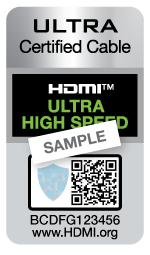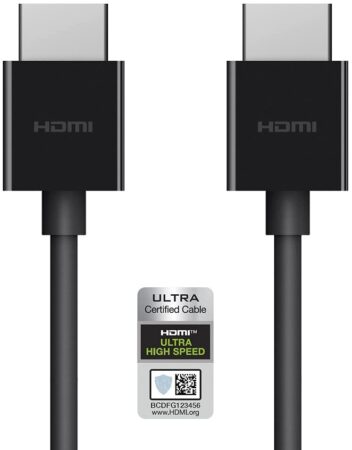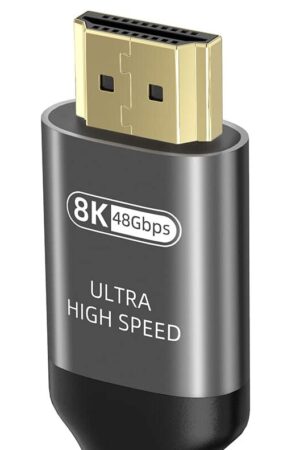When connecting two multimedia devices, you must know what kind of HDMI cable you have.
As the resolution and refresh rates featured by display devices such as monitors and TVs are getting higher and higher, so is the requirement for better HDMI cables.
Hence, “how to check HDMI cable version” is becoming increasingly relevant.
Fortunately, there are a few methods that you can employ to check what kind of HDMI cable you have.
However, before we delve into that, we must understand critical concepts regarding HDMI interface, version, and cables.
TABLE OF CONTENTS
HDMI Interface Version is Not the Same as HDMI Cable Type
It is essential to understand that the HDMI interface differs from the HDMI cable version.
HDMI version of the input and the output ports located on the source device (PC, gaming console, etc.) and the display device (TV, monitor, projector) define the capabilities of the HDMI interface.
For instance, HDMI version 1.4 ports can offer up to 4K resolution at a 30 Hz refresh rate. HDMI 2.0 ports can support up to 4K resolution at a 60Hz refresh rate.
The version of the HDMI ports is the primary consideration when determining whether your video connectivity will support a specific resolution and refresh rate.
The following table shows the different HDMI versions, their max resolution and refresh rate, and the maximum bandwidth they can support.
| HDMI Version | Max Resolution | Max Refresh Rate | Max Bandwidth (Gbit/s) | Effective Bandwidth (Gbit/s) | HDR? | Audio Technology Supported |
|---|---|---|---|---|---|---|
| HDMI 1.0 | 1080p | 1080p @ 60 Hz | 4.95 | 3.96 | No | – 8 Audio Channels |
| HDMI 1.1/1.2 | 1440p | 1440p @ 30 Hz | 4.95 | 3.96 | No | – 8 Audio Channels -Super Audio CDs |
| HDMI 1.3/1.4 | 4096 x 2160 (4K) | 120 Hz @ FHD Resolution 30 Hz @ 4k Resolution 24 Hz @ 4k Resolution | 10.2 | 8.16 | No | – 8 Audio Channels – ARC – Dolby TrueHD – DTS-HD |
| HDMI 2.0 | 4096 x 2160 (4K) | 60 Hz @ 4K Resolution | 18 | 14.40 | Yes | – 32 audio channels, – Dynamic Resolution Adaptation (DRA) – High-Efficiency Advanced Audio Coding (HE-AAC) |
| HDMI 2.1 | Upto 10240 x 4320 (10K) | Upto 120Hz @ 10K | 48 | 42.67 | Yes | – 32 audio channels – eARC |
The HDMI interface version IS NOT THE SAME AS the HDMI Cable version.
The version of the HDMI ports should not be confused with that of the HDMI cable.
Also Read: How to Check the Version of the HDMI PORT?
HDMI Cable Versions (or Types Rather)
Technically speaking, there is no such thing as HDMI Cable VERSION. HDMI cables do not have controllers or ICs with software and drivers that can be updated.
HDMI cables are wires that carry signals from one port to the other.
However, the quality of the wiring inside determines what TYPE of cable a particular HDMI cable is in terms of PERFORMANCE STANDARDS.
The performance standard of an HDMI cable may differ, and hence specific HDMI cables may not be able to carry a high data rate generated by the newer HDMI 2.0 and HDMI 2.1 ports.
A few years back, when the only prevalent HDMI interface was 1.4, there was only one type of performance category of HDMI cables. Hence, choosing a suitable HDMI cable wasn’t quite an issue.
However, with the ever-increasing data rate, changes had to be made to HDMI cables. Cables nowadays carry performance certifications given to them by HDMI.org itself.
The following table shows the TYPES of HDMI cables defined by their performance standards.
| HDMI Standard Certification | Max Data Rate Supported | Specs Supported | Best Port |
|---|---|---|---|
| Standard | 4.95 Gb/s | 720 or 1080P @ 60Hz | <1.4 |
| High Speed | 10.2 Gb/s | FHD @ 60Hz QHD @ 60Hz 4K @ 30Hz | 1.4 |
| Premium High Speed | 18 Gb/s | 4k @ 60Hz | 2.0 |
| Ultra High Speed | 48 Gb/s | 4K @ 60Hz 8K @ 120Hz 10K @ 120hz | 2.1 |
Again, it is worth noting that while related, the HDMI port/interface version should not be confused with the HDMI cable type.
Hence, there is no HDMI 2.0 cable or HDMI 2.1 cable. There is a Premium High-Speed certified cable that is CAPABLE of supporting HDMI 2.0 specs, and there is an Ultra High-Speed certified cable that is capable of supporting HDMI 2.1 specs.
People often refer to Premium High Speed and Ultra High-Speed cables as HDMI 2.0 and HDMI 2.1 cables, respectively, which can make sense to the experts but can be highly confusing to newbies.
Also Read: What Does HDMI Cable Look Like?
So How to Check HDMI Cable Version?
Now that you understand all the important jargon, we can tackle the question: how do we check the HDMI cable version or the HDMI cable type based on its performance certification?
Unfortunately, all HDMI cables look the same visually. In other words, looking at it won’t tell the difference between a Standard or an Ultra High-Speed HDMI cable.
Additionally, as mentioned earlier, HDMI cables do not have any drivers, IC, or controllers. Hence you cannot check out their type or how much bandwidth they can carry from within your PC or through software.
So the options to check what HDMI cable you have is pretty limited.
Here are two methods that can work.
1. Checking the Performance Specifications of the Cable
You can check what type of HDMI cable you have by looking at its performance specifications.
There are three ways to go about this. You can check its
- Data Rate Specification
- Resolution and Refresh Rate Specification
- Performance Certification
If your HDMI cable’s package or its listing highlights any one of these, you would know what version of cable you have.
You will need the package or the technical spec sheet of the cable, though.
Deducing Cable Type through Data Rate:
The Data Rate is provided regarding Gbit/s, Gb/s, or Gbps. Hence if an HDMI cable has a rated Gbit/s of 10.2, you have a High-Speed HDMI cable capable of supporting up to 4K @ 30Hz.
Similarly, if the HDMI cable is rated at 18 Gbit/s, you have a Premium Ultra High-Speed cable suitable for HDMI 2.0 ports or 4K @ 60Hz TVs and monitors.
Deducing Cable Type through Resolution and Refresh Rate:
Similarly, your HDMI cable type can be deduced through its rated resolution and refresh rate.
If a cable is listed with specs as 4K @ 30Hz, then you have a High-Speed HDMI cable suitable for HDMI 1.4 port.
Similarly, if a cable offers 4K @ 60Hz, you have a Premium High-Speed cable suitable for HDMI 2.0 ports.
Identifying Cable Type through Performance Certification:
HDMI.org provides performance certification to certain brands of HDMI cables.
These cables can be identified through a label on their packaging. The following are certification labels provided by HDMI.org.




Note that Premium High Speed and Ultra High-Speed certified cables have a QR code on the label that can be scanned to verify their certification.

Premium High Speed and Ultra High-Speed cables may also have the labels printed on the cable jacket. Other times, you may find the specification labeled on top of the connector.

Also Read: Are All HDMI Cables 4K?
2. Checking What HDMI Cable You Have Through Trial And Error
This is more of a brute-force method.
If you have misplaced or lost the package of your HDMI cable – which you most certainly would have if you have an old cable at hand – and if the cable has no labels on it whatsoever, then the only way to check what version it is is through trial and error.
As a rule of thumb, almost all HDMI cables are compliant with the specs of HDMI 1.4. Therefore, carrying 1080p @ 60Hz or 4K @ 30Hz is not an issue for even the most basic and old HDMI cables.
The issue arises when connecting newer TVs and monitors with powerful specs such as 4K @ 60Hz or 4K @ 120Hz, or even 8K.
To connect to a 4K@60Hz TV, you must have at least a Premium High Speed. So the only way to check if the cable you have at hand supports this is to do some trial and error.
Checking if You Have a Premium High-Speed Cable
To check if you have a Premium High-Speed Cable (aka HDMI 2.0 cable, 18 Gbit/s cable):
- Check if the cable works on a Full HD (1080) PC monitor or a Full HD TV
- Then check again if the cable works in your 4K@60Hz TV or monitor.
If the cable works in the first instance but fails and shows a blank screen in the second, then you DO NOT have a Premium High-Speed cable.
Additionally, if the cable works in the second instance, but the specs are capped at 4K @ 30Hz, then again, you do NOT have a Premium High-Speed cable.
You most probably have a High Speed 10.2 Gbit/s HDMI cable.
It is essential to check the cable on a Full HD monitor or TV first to establish whether it is faulty.
Checking If You Have an Ultra High-Speed Cable
You can follow a similar trial and error method to check if you have an Ultra High Speed (HDMI 2.1) cable.
- Check if the cable works on a Full HD (1080) PC monitor or a Full HD TV
- Check if the cable works on your 4K @ 120Hz, or your 8K TV or monitor.
Again, if the cable works in the first instance, we can deduce that it is not faulty.
If it does not work on the second instance, you have a High Speed or a Premium High-Speed cable.
Again, for you to conclude that you have an Ultra High-Speed cable, not only does the TV or monitor have to run, it must run at specs HIGHER than 4K @ 60 Hz!
Also Read: Do HDMI Cables Have Different Ends?
Also Read: Is HDMI Backwards Compatible?
Also Read: Does it Matter Which HDMI Port I Use?
Final Words
This article is aimed to serve as a comprehensive guide on how to check the HDMI cable version.
Identifying a High Speed or HDMI 1.4 cable is not an issue since all HDMI cables are backward compatible and technically compliant with 1.4 specs at the very least.
The issue is identifying whether an HDMI cable is 2.0 or 2.1 (Premium High Speed or Ultra High Speed).
This can generally be done by reading the specs on the listing or the packaging. If you have misplaced the packaging or can’t find the listing, then the only other way is to test it yourself.
If you have anything more to add, or if I have missed something of value in this article, please let me know in the comments below.
Also Read: What is HDMI Input Used For?
FREQUENTLY ASKED QUESTIONS
1. How to Tell if HDMI Cable is 2.0?
The simplest way to tell if an HDMI cable is 2.0 is to read through the specifications on the package it came in or on its listing online. An HDMI 2.0 cable should have some of the following specifications highlighted:
–Name/Label: Premium High Speed
–Specs: 4K @ 60 Hz
–Data Rate: 18 Gbit/s (Gb/s, Gbps)
It may also have a certification label provided by HDMI.org as follows:

You can also check if the cable is 2.0 by testing it yourself. Plug it into a 4K HDMI TV or monitor and check what refresh rate it caps at. You have an older HDMI 1.4 cable if it limits to 30Hz, and you have an HDMI 2.0 cable if it caps at 60Hz.
2. How to Tell if HDMI Cable is 2.1?
You can follow the same tips mentioned in the FAQ above. HDMI 2.1 cables have the following specifications highlighted on their listing or mentioned on their packaging:
Name/Label: Ultra High Speed
Specs: 8K @ 120Hz or 4K @ 120Hz
Data Rate: 48 Gbit/s (Gb/s, Gbps)

You can also test your cable on your 4K @ 120Hz TV to see if it works and operates at 120Hz. Some cables may also carry this certification label:
3. Can I use an older version HDMI cable with newer devices, or do I need to upgrade?
In most cases, you can use an older version HDMI cable with newer devices, but you may not get the full benefits of the newer device’s features.
For example, if you use an HDMI 1.4 cable with a device that supports HDMI 2.0, you won’t be able to take advantage of features like 4K resolution or HDR.
To get the best performance and compatibility, it’s recommended to use an HDMI cable that matches the version of your device.
4. Can a faulty HDMI cable cause problems with my device, and how can I troubleshoot HDMI-related issues?
Yes, a faulty HDMI cable can cause problems with your device, such as flickering or loss of signal.
If you’re experiencing HDMI-related issues, the first step is to check the cable for damage or loose connections.
You should also try using a different HDMI cable to see if the issue is with the cable or the device.
If the problem persists, you may need to troubleshoot the device or consult a technician.
5. How do I choose the right HDMI cable for my needs, and what factors should I consider when making a purchase?
When choosing an HDMI cable, there are several factors to consider, including the version of the cable, the length you need, and any special features you require, such as Ethernet or ARC.
It’s important to choose an HDMI cable that matches the version of your device to ensure optimal performance and compatibility.
Additionally, you should consider the length of the cable and choose one that is long enough to reach your devices but not so long that it causes signal loss.
Finally, you should check the specifications of your devices and choose an HDMI cable that supports any special features you need.

Finally!
All the answers in a comprehensive yet easily understood format.
Great Job Sir!